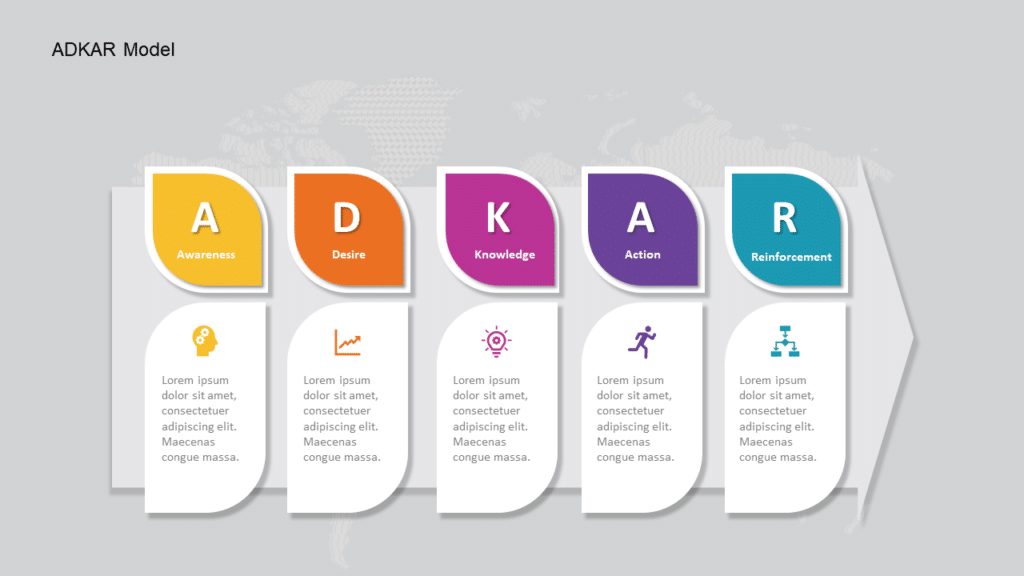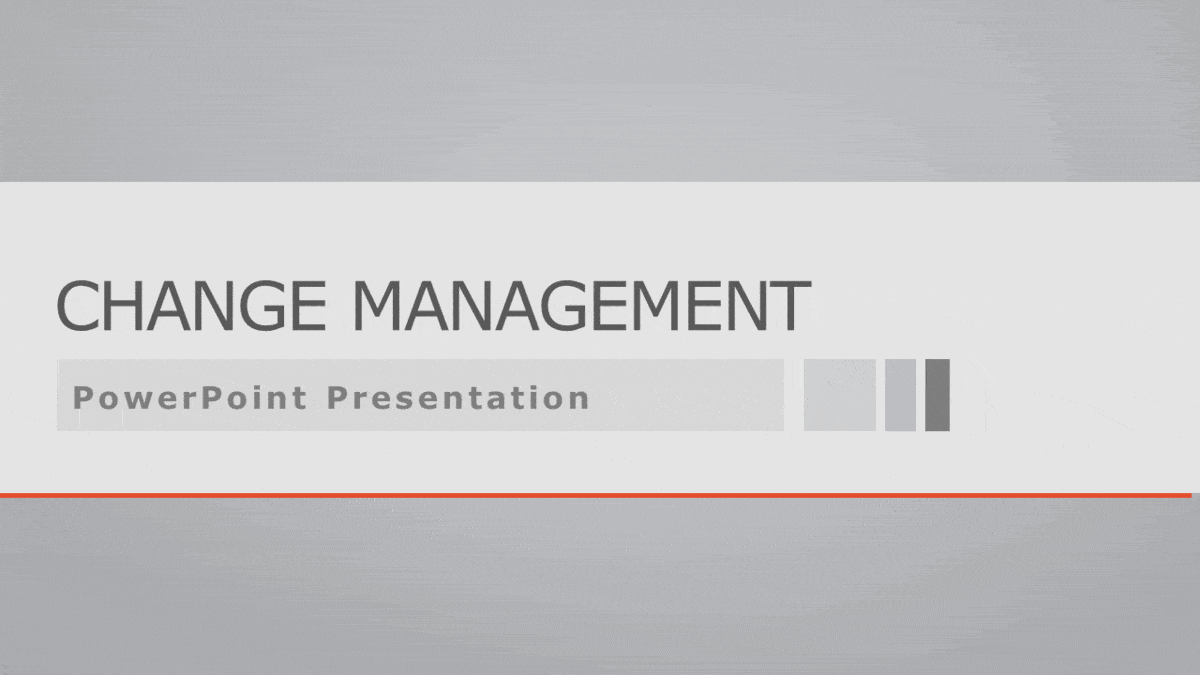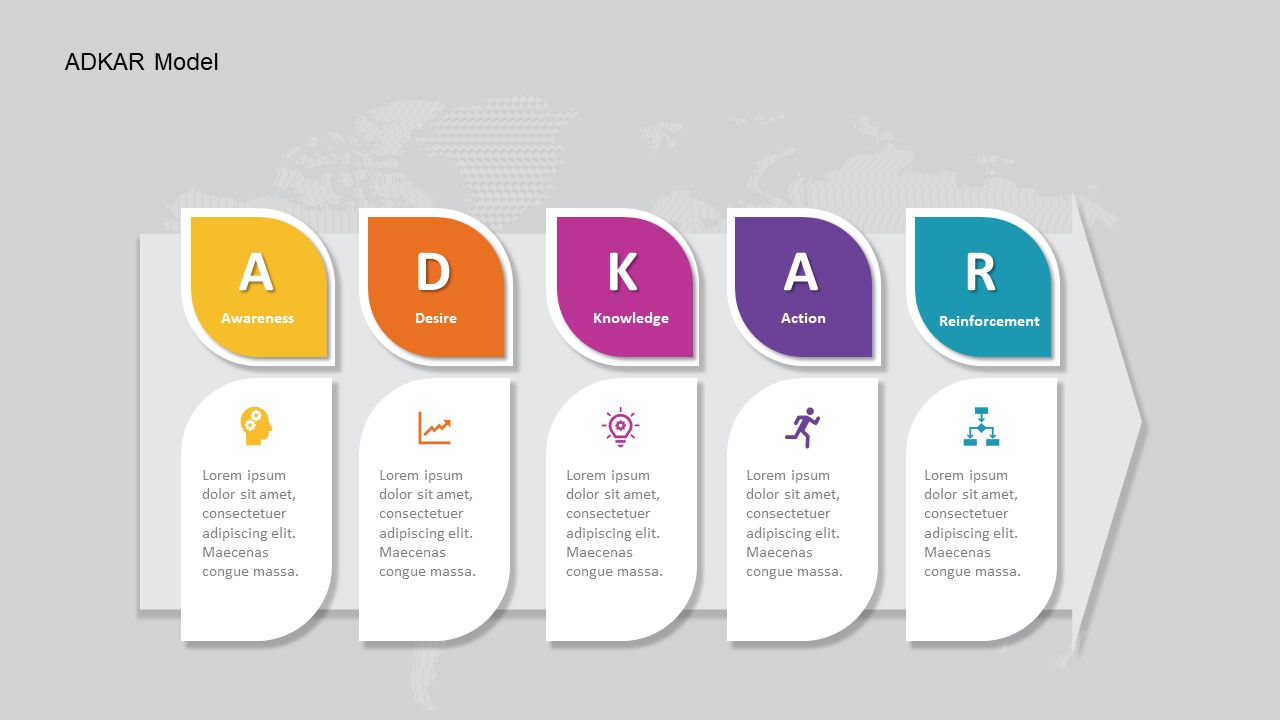Across enterprises, changes must be made on a regular basis in order to improve. People, on the other hand, tend to be change-averse. It is because the why behind the change is not usually clearly conveyed or understood at all levels of a business.
However, it should be. As a result, change management strategies such as the ADKAR model are developed to handle the human aspect of communicating and executing change within a company.
The ADKAR model is one of the ways that assist businesses in aligning their employees with their process improvement frameworks and change management. Let’s look at how you, as a company leader, can effectively apply the ADKAR model in practice to elevate your team’s performance.
What Is The ADKAR Model?
The ADKAR Model of organizational change is an outcome-oriented organizational change strategy that strives to reduce organizational resistance to change.
Jeff Hiatt created the ADKAR model in 2003, which is a short form for:
- Awareness
- Desire
- Knowledge
- Ability
- Reinforcement
Prosci, a change management consulting company, popularised the ADKAR paradigm. It was created as a result of research involving 900 organizations from 59 countries.
The ADKAR model’s purpose is to provide coaching and support to people inside companies while they undergo transformation.
How Can You Apply The ADKAR Model In Your Organization?
The ADKAR Model, because it is outcome-oriented, can be used to support change by establishing explicit milestones to be met throughout the process.
Everyone participating in the change must achieve each objective, even if different persons achieve different goals at different time periods. For example, one individual may already want to change, but another is only now becoming mindful of the need to change.
The ADKAR Model’s five consecutive objectives indicate regions of resistance, which is one of its most useful features. Is someone unable to change, for example, because they do not comprehend why the change is necessary (Awareness) or because they do not understand how to accomplish the change (Knowledge)?
Once you determine whatever step someone is stuck on, you will be better equipped to coach them through a stage.
Spread Awareness Of The Need To Change
Without a question, conveying the need for change is critical, but building awareness for the change entails more than just proclaiming it.
Employees must not only grasp the logic behind the need for change, but they must also come to agree with that thinking in order to be really conscious of its importance. Begin by clearly explaining why the change is required.
Assume you’re launching Microsoft Sharepoint as an example. Begin by emphasizing how difficult it is for employees to access documents and interact with the in-office team when they travel or work from home. The organization could employ Microsoft’s SharePoint cloud-based technology to address this issue.
Make a point of highlighting the advantages of the change as they pertain to the people who will be affected. SharePoint will enable off-site employees to readily access documents and data in this situation. Switching will improve communication and reduce information silos.
Finally, always encourage your employees to ask questions about how you came up with the change, how it will be executed, and other components of the change process plan.
Foster Desire To Bring Out The Change
Employees may understand why a change is necessary, but it does not imply that they desire the change. They must desire the change in order to embrace it. Fortunately, you can cultivate that desire.
Begin by selecting transformational leaders. Your change leaders will not only show public support for the change, but they will also organically connect with those who will be affected by it. Choose change leaders who can connect to how daily routines will be changed in order to give personalized assistance and guidance.
Change leaders must be explicit about the advantages of the change as they pertain to specific individuals or teams in order to build desire.
For example, you may wish to replace three independent tools with Salesforce to save money, but this isn’t a strong motivation for staff. Instead, frame the change as something that will help them in their daily work life.
In this example, Salesforce will let them run reports, manage client connections, and implement marketing plans all in one location, saving them the hassle of utilizing three different applications.
When it comes to developing desire, resistance to change is a huge impediment. Resistance is to be expected, but you must understand why it exists.
Are individuals concerned that they lack the necessary abilities to enact change?
Is it because they are concerned about how it will affect their job responsibilities?
Employees that are dissatisfied with the extra effort required to learn something new?
Once you’ve identified the core reason for the resistance, confront it head-on and, if required, revise your change implementation strategy.
Provide Knowledge On How To Change
The ADKAR Model’s knowledge aspect is highly concerned with employee training. To initiate the change, your team must understand how their duties, skills, tools, and procedures will be affected.
Given that each milestone must be met by each individual, knowledge-building must be targeted. Provide information that is directly applicable to the tasks of each team or individual.
For example, if you are bringing in new software, the IT team may be in charge of getting everyone set up to utilize it, whilst other departments may need to concentrate more on how to use the product. Even though the overall change is the same, the knowledge required to fulfill varied tasks in the change is different.
Take the time to consider what new skills, tools, and responsibilities the change may necessitate. You will be able to structure your change schedule around the essential skill development if you do so. Remember that too much change at once can be disconcerting and lead to resistance. If your change necessitates employees learning a considerable quantity of new information and/or mastering new abilities, apply it gradually.
Another strategy for improving understanding is to use a range of unique staff training methods, such as:
- Regular classroom training
- Job shadowing and mentorship
- Videos
- Series of blog posts
- Self-directed interactive learning
Of course, knowledge-building should extend beyond just supporting transformation. It is also critical to supply information that helps your team to see the transformation through to completion.
Ensure That Employees Have The Ability To Make The Change
Employees’ confidence in their own capabilities impacts whether or not they can or will accomplish something, regardless of how well they know how to do it.
While many baseball fans understand the fundamentals of hitting a curveball, not all of them would make excellent pitchers, according to the Prosci change management technique.
Put change leaders in charge of teaching people or teams to bridge the knowledge-ability gap. Empower change agents with gathering input from their teams and alerting them to any concerns and roadblocks.
Hands-on training is also incredibly beneficial. Giving teams the opportunity to test the change before completely implementing it allows them to gain confidence.
You may also track performance and offer thorough feedback. Consider executing larger-scale changes in stages so that you can spot concerns early on and make revisions to your implementation strategy.
Reinforce The Change
The initial momentum may carry you to the finish line, but if staff fall back on old patterns, you won’t cross it. Once new procedures are in place, new software is deployed, or a new organizational structure is in place, encourage the change long after it has been implemented.
Celebrate achievement both during and after the change to generate and sustain excitement. Try the following unique motivational techniques:
- Zendesk’s Champagne Campaign entails establishing minor goals for staff and then rewarding accomplishment with a tiny bottle of champagne on their workstations.
- iDoneThis’ weekly show-and-tell video call, in which staff may express what they are proud of doing.
When people go back into old patterns, correct their faults and terrible behavior in private. Praise, on the other hand, should be given openly so that the entire company may rejoice together.
In the meanwhile, keep collecting input. Although the transformation process is “complete,” employee input is still crucial. Listen to employees to discover pain points and areas where further assistance might be useful.
Finally, include time in your change management strategy for reinforcement. If you want to be entirely switched over to SharePoint by the end of Q3, you should keep monitoring and reinforcing the shift throughout Q4. Change does not happen overnight; reinforcing activities should last long beyond the completion date.
Few Change Management Templates

ADKAR Model
Source: ADKAR Model by SlideUpLift

Animated Change Management
Source: Animated Change Management by SlideUpLift

Change Management Presentation
Source: Change Management Presentation by SlideUpLift
Wrapping It Up
The ADKAR model is an appropriate foundation for a wide range of organizational changes. However, you should not rely only on the ADKAR change management process. Each milestone may need further assistance from change leaders, transformation management software, and staff, so be prepared to seek it.
You could also think about integrating the ADKAR model with other well-known change management frameworks. The ADKAR model might be used with people-centric strategies to provide a framework for dealing with emotional reactions.
Looking For Powerpoint Design Agency?
Call Pursho @ 0731-6725516
Telegram Group One Must Follow :
For Startups: https://t.me/daily_business_reads
#Bring #Change



